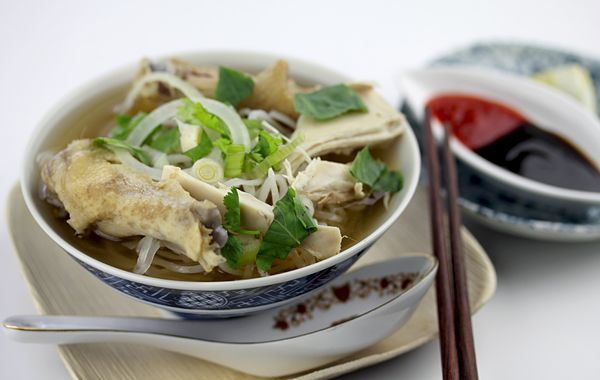I’ve probably said it in on countless occasions; I love pho! The most commonly known version of the Vietnamese soup is pho bò (beef noodle soup) but it’s pretty high in cholesterol due to the bone marrow from the quantity of beef bones used. For a lighter version that’s equally delicious, I made pho gà, chicken noodle soup with ginger.
Pho gà is judged on two main criteria: the flavor of the chicken broth and the quality of the chicken. To ensure that the broth turned out well, I used a generous helping of ginger and 6 chicken carcasses, which are very inexpensive at the Asian market. I served the soup with special Vietnamese chickens, called gà di bo (it literally translates to “walking chickens”). They’re free-range chickens and the texture of the meat is firmer than regular chicken. The cost is higher (count $13 per chicken) but so worth it when making this dish.
1. Info for Pho Ga Recipe (Vietnamese Chicken Noodle Soup with Ginger)
- Cook Time: unavailable
- Total Time: unavailable
- Servings: 8
- Calories: unavailable
2. Ingredients for Pho Ga Recipe (Vietnamese Chicken Noodle Soup with Ginger)
- 3 whole “ga di bo” chickens
- 3 chicken carcasses
- 4 cups chicken broth
- 4 yellow onions (1 whole, 3 chopped)
- 1 (6-inch) chunk fresh ginger, sliced
- 1/4 cup canola oil (or any neutral oil)
- 1 (2-inch) chunk rock sugar (or 3 tablespoons granulated sugar)
- 3 cinnamon sticks, broken in half
- 2 tablespoons coriander seeds
- 2 tablespoons star anise seeds
- 1 teaspoon cloves
- 10 green cardamom pods, slightly crushed
- 2 teaspoons whole black peppercorns
- 4 teaspoons mushroom seasoning salt
- 1/3 cup salt
- 1 teaspoon MSG (optional)
- 1 (4-inch) chunk daikon turnip, peeled
- 2 packages carrots, peeled
- 2 (8-ounce) dried rice vermicelli noodles
- 1 bunch Vietnamese mint
- 1 bunch Thai basil
- 4 red Thai bird chiles, finely chopped
- 3 limes, cut into wedges
- 4 tablespoons cilantro, finely chopped
- 2 green onions, thinly sliced
- 1 white onion (milder in flavor), sliced paper-thin
- 2 cups bean sprouts
- 1 teaspoon black pepper, freshly cracked
- 2 jalapeu00f1o peppers, sliced
3. Directions:
3.1 Prepping the rice noodles
Soak the dried rice noodles in a big bowl filled with cold water for about 30 minutes. Drain the water using a colander. Set aside until the chicken broth is ready.
3.2 Prepping the spices, ginger and onion
In a giant spice strainer (see tips below), combine the cinnamon, star anise, coriander seeds, black peppercorns, cloves andcardamom. Set aside.
Cut the ginger root in half. Remove any dirt from one piece, peel it with the edge of a spoon, then thinly slice it.
Wash the remaining unpeeled ginger; pat dry. Peel one whole yellow onion without cutting the stem to make sure the onion doesn’t fall apart in the broth. Place a grill on your stove and char all the skin of the ginger and onion. Wrap them in aluminum foil. Let cool for about 10 minutes. Wash the ginger and onion under running tap water; the blackened skin will come right off. Bruise the ginger using a hammer to loosen the flesh and help release all its flavor.
3.3 Caramelizing onions
Slice the rest of the yellow onions. Heat the oil in a pan. Fry the onions, stirring frequently to prevent the onion from burning, until the color is evenly golden brown. Transfer to a plate, leaving as much oil as possible in the pan (reserve it for the boiled rice noodles and make flavorful vinaigrette using the remaining oil).
3.4 Making pho gà chicken broth
Wash the chicken carcasses and whole chickens.
Fill a large stockpot with 6-½ quarts of water. Bring to a roaring boil. Add the sliced ginger, fried onions, whole daikon, carrots, the strainer of spices and the charred ginger and onion to the pot. Bring the liquid back to a boil. Add the whole chickens and chicken carcasses to the onion broth. Cook for about 10-12 minutes. Remove the whole chickens from the pot. Let them cool a bit until you can handle them without discomfort. Make several deep diagonal incisions throughout the birds’ flesh. Place the chickens back in the broth. Season with 1 tablespoon salt. Bring to a boil again and cook for another 5 minutes (cook the chicken no more than 15 minutes).
Remove the whole chickens again from the broth. Let cool a bit. Shred the meat. Set the meat aside on a platter. Return the chicken carcasses to the pot.
Lower the heat from the pot to a bubbly simmer. Cook for about 2 hours. Regularly skim the impurities rising to the surface of the broth using a fine mesh strainer. Season with salt, mushroom powder, sugar and MSG if you use it (see tips). Cook for another 30-45 minutes.
The chicken broth is ready. Get the rest of the pho preparation ready…
3.5 Boiling the rice noodles
When you’re ready to serve, fill a medium-sized pan with about 2 quarts of water. Bring to a boil. Then place a deep bouillon strainer (or a large strainer that can fit in the pan) and add a scant cup of the rice noodles. Wait for the water to come back to a boil (about 1-2 minutes) then cook for about 30-45 more seconds. Lift the strainer, drain the liquid and transfer the noodles to an individual serving bowl.
Drizzle with 1 teaspoon of onion-flavored oil (if used).
Repeat the same procedure for each individual bowl.
3.6 Assembly time
Line up the serving bowls. Place a little chopped white onion, some green onions, bean sprouts, mint, basil and cilantro in each bowl. Add the rice noodles. Ladle the boiling chicken broth you have prepared into the bowls. Top with chicken pieces.
Garnish with more green onions, basil and cilantro. Serve with Sriracha, hoisin sauce, lime wedges and fresh sliced green chiles on the side.
Serve immediately.
Bon appétit!
4. Tips and advices:
- You can find ready-packed chicken carcasses at Asian stores. Otherwise, you could use the chicken thighs and chicken breasts to make other dishes such as chicken cacciatore, goi gà (Vietnamese chicken salad) and keep the bones and carcasses for making the flavorful chicken broth.
- I purposely do not salt the broth at the beginning, but wait to add salt until the chickens are fully cooked. This way the broth remains clear.
- If you do not own a giant spice strainer for the pho spices, you can use a cheesecloth. Place all the spices in the cloth and tie it in a tight knot.
- I love bean sprouts; they add some crunchiness to the dish.
- Mushroom seasoning salt brings a very distinct, earthy flavor to the sauce. You can find it at gourmet specialy stores or in most Korean stores.
- I charred the onion and ginger root to caramelize the outer layer and enhance the sweetness of the broth. This method is very common when making pho.
- I am not a big fan of MSG (monosodium glutamate); some people like to add it to the chicken broth, but I don’t. Daikon is an Asian turnip that looks like a large white carrot. I use this root a lot for making broth for the natural sweetness it brings.
- You can find rock sugar in any Asian stores. You can also use granulated sugar.
- Vietnamese mint has a very different flavor from regular mint. It also has darker vein marking on the leaves. It’s commonly used in Asian salads and also in springrolls (goi cuon in Vietnamese).
- If you have chicken broth left over; pour it into containers and store in the freezer. You can keep them up to 6 months.
- You can make the very same soup with duck meat.

